 This game is centuries old and is apparently mentioned in old folk tales, period chronicles, etc. While I'm still looking for actual references, the evidence that this game is period is at least as good as the evidence I've seen for Kubb.
This game is centuries old and is apparently mentioned in old folk tales, period chronicles, etc. While I'm still looking for actual references, the evidence that this game is period is at least as good as the evidence I've seen for Kubb.

 This game is centuries old and is apparently mentioned in old folk tales, period chronicles, etc. While I'm still looking for actual references, the evidence that this game is period is at least as good as the evidence I've seen for Kubb.
This game is centuries old and is apparently mentioned in old folk tales, period chronicles, etc. While I'm still looking for actual references, the evidence that this game is period is at least as good as the evidence I've seen for Kubb.
The game goes by many names in Russian villages: ryukhi, chukhi, chushki, kletki, skrakli, derevanye babki...
The modern version of gorodki was formalized with official rules in the 1920s. The rules I will present here are based on the modern rules. I do not know what the "period" rules would have been, and I strongly suspect that, since almost every Russian village had it's own name for the game, they all probably had their own versions of the game.
The object of the game is to throw a bat (bit) to dislodge blocks (gorodki) from a city (gorod) in as few throws as possible. It supposedly can be played on any surface, but I have discovered that thick American-style lawns really make it difficult. Packed dirt/gravel and asphalt are much better.
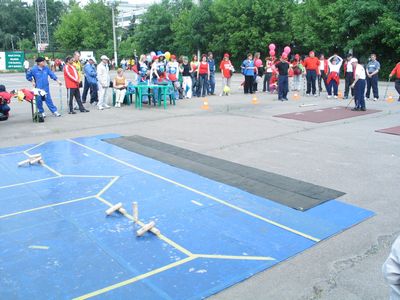
|
Equipment: 2-4 Bats - 1 1/4 inch diameter (3 to 3.5 cm) rods not more than a meter (39 inches long) made of wood, plastic, etc. Tournament bats in Russia have metal bands for durability. I made mine of yard-long pieces of 1 1/4 inch pine closet rod. (One has already started to split so I may be adding metal bands or finding a more durable wood.) 10-12 Gorodki - 1 3/4 inch (4.5cm) diameter cylinders about 8 inches (20cm) long. I made mine from a 1 3/4 inch oak handrail. (The handrail came with one side a little flattened which makes it easier to stack some of the figures.)
|
The Field
Each "city" is 6 feet (2m) square. The figures of gorodki are set up in the middle of the front line of the city.
In front of the city (gorod) is the suburb (prigorod). There is a penalty line (shtrafnaya liniya) at the front of the suburb that the bat should not hit on its way to the gorodki. (I think the prigorod and penalty line could be optional for "rustic" simplified versions of the game.)
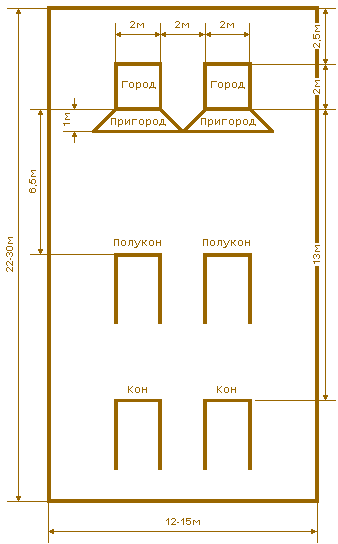
The main throwing line (kon) is 42.6 feet (13m) from the city. Another throwing line (polukon) is 21.3 feet (6.5m) from the city, halfway between the city and the kon.
Modern gorodki is set up with the opposing cities side by side, as in the figure to the right. The illustration at the top of this page shows them across from each other, more like Kubb and related games. The line halfway between the two teams would be the polukon.
With the face-to-face set-up, one should obviously stand a safe distance to the side when the other team is throwing.
Game Play:
The first throw at a figure of gorodki is made from the kon. As soon as one of the gorodki is expelled from the city, the players can throw from the polukon to expell the rest of the gorodki from that figure. (Except for the figure "letter" (pismo), which must be expelled from the kon.)
If a gorodok rolls out of the city, then rolls back in, it is still considered "out". If a gorodok falls from its figure accidentally - breeze from a near miss, earthquake, etc. - then it is simply put back into place. If a gorodok ends up in the penalty area in front of the prigorod, it is picked up and placed in middle of the prigorod.
Once all the gorodki from a figure are expelled, then the next figure in the sequence is set up on the front edge of the city. (And throwing resumes from the kon until the next gorodok is expelled.)
Teams/players take turns throwing their bats at the city. In the modern game, each player seems to get 2 throws for their turn since most commercial gorodki sets come with 2 bats.
The side that gets through all the whole sequence of figures first, wins.
Children's versions of the game omit some of the figures (for example, doing 10 instead of 15 figures) and shorten the field, for example, starting throws from the polukon instead of the kon.
The 15 modern gorodki figures (use 5 gorodki each so only need 10 total gorodki to play):
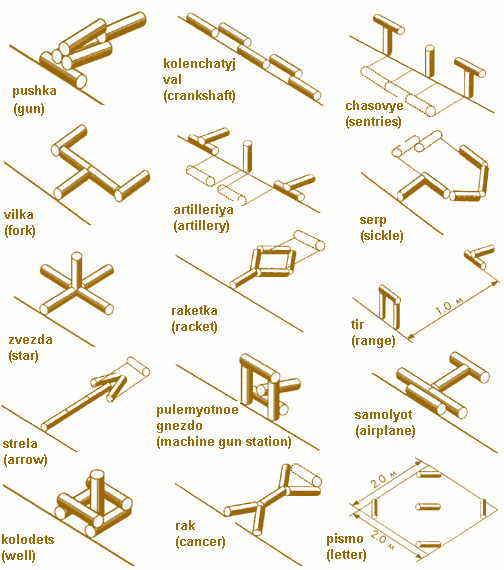
These are the 14 figures I found for ryukhi. They are made with 4-6 gorodki each (so need 12 gorodki to play this version):
|
1. Плашмя, одна рюха около другой. (Lying down next to each other) 2. Плашмя, одна рюха стоит. (Lying down with the one middle standing) 3. Рюхи лежат боковой поверхностью вперед. (Lying down next to each other the other direction) 4. Рюхи стоят в два ряда.(Standing in 2 rows) 5. По одной. (Lying end to end) 6. Парами. (Lying in pairs) 7. Фигура «Гвоздь». (The "nail") 8. Фигура «Слон». (The "elephant") 9. Фигура «Ворота». (The "gate") 10. Фигура «Поезд». (The "train") 11. Фигура «Колотушка». (The "clapper") 12. Фигура «Фонарь». (The "lamp") 13. Фигура «Бутылка». (The "bottle") 14. Фигура «Колодец». (The "well") |
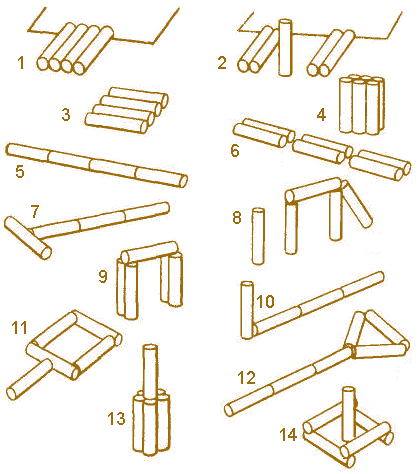
|
And this a the set of 15 figures (modified from the above) that I decided would be fun for our Shire:
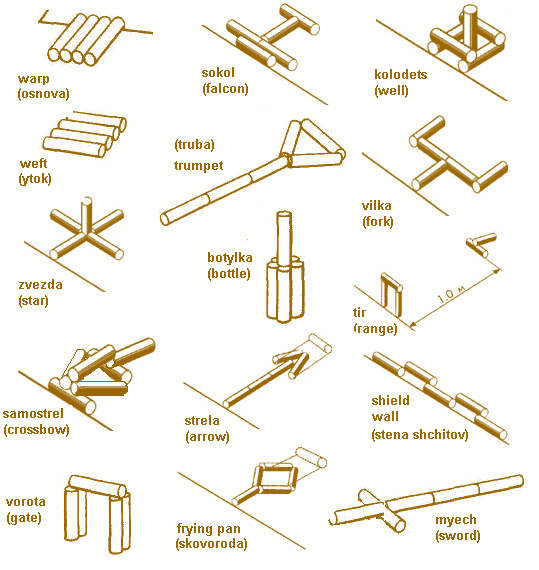
References:
Back to Russian Material